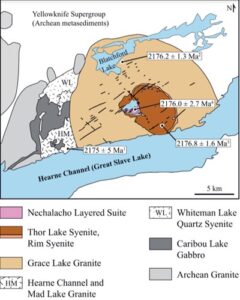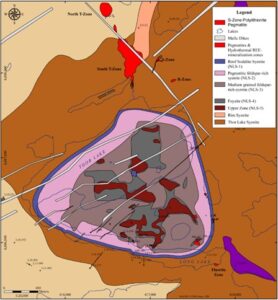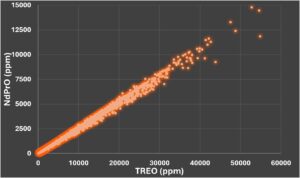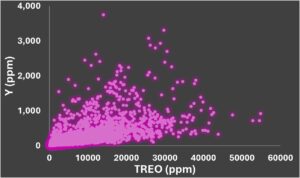Geological background
Summary
- Large shallow magmatic-hydrothermal process generated large deposits of shallow of multi-element rare metal and REE mineralization
- Exploration started in the 1970’s, which two former attempts at small scale mining
- Most exploration undertaken on the larger Tardiff body
- Tardiff body comprised multiple subhorizontal zones/bands of rare earth mineralization where LREE-rich mineralization is characterized in the upper zone with the basal zone particularly enriched in HREE mineralization.
- Upper Tardiff: initial wholerock geochemistry (from published 2023 drill holes) and mineralogical data indicated fluorcarbonates (e.g., bastnäsite, synchysite, parisite) are the main hosts of LREE mineralization. Variations in fluorcarbonate abundances are interpreted to drive the TREO grade range witnessed in the drilling results with the tight NdPr:TREO ratio being comparable to the ration observed in these carbonate minerals. Interestingly this NdPr:TREO ratio is also generally reflected in the total MRE and the mineralogical relationships to wholerock geochemistry and LREE deportment in mineral assemblages will be examined in more detail in ongoing metallurgical work.
Regional Geological Background
Blatchford Lake Igneous Complex
The Blatchford Lake Igneous Complex is part of a Paleoproterozoic (2185–2175 Ma) magmatic event on the Slave Craton that includes a range of approximately synchronous anorogenic mafic and felsic intrusive rocks. The Blatchford Lake Igneous Complex has been dated at 2176 Ma and includes gabbro, granite, silica-saturated syenite, granitic pegmatite, and a central nepheline syenite termed the Nechalacho Layered Suite (Figure 1). The various phases of the complex are thought to be controlled by variable partial mantle melting and fractional crystallization progressing towards the magma that formed the extremely fractionated Nechalacho Layered Suite and associated pegmatites.

Figure 1: Geology of the Blatchford Lake Igneous Complex
(Source: Möller & Williams-Jones, 2016)
Thor Lake Rare Metal Deposits
The Thor Lake rare metal deposits include the Nechalacho deposit, the North and South T-Zone, as well as the R-, S-, and Fluorite Zones (Figure 2). The latter mentioned zones have been interpreted to have formed from late-magmatic volatile-rich residual melts expelled from the Nechalacho Layered Suite (NLS) during the final stages of crystallization. This hypothesis potentially is geologically supported by the presence of a feldspathic ‘feeder’ dyke connecting the South T-Zone to Nechalacho (Figure 9). The Nechalacho REE deposit is deemed to have formed near the top of the Nechalacho Layered Suite, an agpaitic nepheline syenite intrusion that is interpreted have crystallized upward and at the final stage, downward concentrate a residual rare metal-rich melt. The eudialyte-bearing syenites of the NLS are similar to those of the Ilímaussaq intrusion in Greenland, but are interpreted to be manifest from a more fractionated system as indicated by relative mineral chemistry differences (e.g., presence of magmatic end member aegirine and annite). In addition, the upper part of the NLS was affected by a strong hydrothermal alteration overprint. In unaltered portions of the NLS, primary magmatic mineral assemblages include eudialyte, aegirine, nepheline, sodalite, and feldspars.

Figure 2: Geological Map of Thor Lake area
(Source: Möller & Williams-Jones, 2016)
Nechalacho Igneous Complex and REE mineralisation
The Nechalacho deposit consists of hydrothermally altered eudialyte-rich syenite and eudialyte crystal cumulates that formed in multiple subhorizontal layers. Eudialyte is a complex zirconosilicate mineral that can incorporate high field strength elements such as REE, Nb, and Ta. Magmatic eudialyte has been identified in unaltered portions of Nechalacho. In comparison, the Ilímaussaq intrusion has been mapped to host at least twenty-nine eudialyte-bearing syenite layers, which are interpreted to have formed by cumulate processes (Ferguson, 1964); dynamic magma chamber-scale regimes as well as intra-layer crystallization regimes also have been described (Sørensen, 2001). Similar processes are possibly responsible for the formation of the eudialyte-bearing horizontal layers at Nechalacho. These different layers have been referred to as the Basal and Upper Zones based on their relative depth from surface; however, other similar bands also have been documented outside these particular reference zones. On a simplistic geochemical basis, the Upper Zones are relatively LREE enriched and HREE depleted relative to the Basal Zone.
Significant hydrothermal alteration has overprinted the upper 200-250 metre of the Nechalacho igneous complex, and is interpreted to represent either late-magmatic autometasomatism or a late regional overprint. The hydrothermal alteration assemblage comprises carbonate minerals, quartz, zircon, magnetite, biotite, chlorite and illite. Primary magmatic textures are commonly preserved, although with greater intensity of alteration textural retention is commonly lost within the eudialyte syenite layers.

Figure 3: Wholerock geochemical associations: TREO vs Nd+Pr 1
1. Wholerock data tabled are from dataset informing drill results release on 30 May 2023, 21 November 2023, and 6 February 2024. TREO represents the sum of La2O3, CeO2, Nd2O3, Pr6O11, Sm2O3, Eu2O3, Gd2O3, Tb4O7, Dy2O3, Ho2O3, Er2O3, Tm2O3, Yb2O3, and Lu2O3. NdPr represents Nd2O3 + Pr6O11. These represent holes distributed over the resource area, sample only a portion of the resource, but we note that the tightly defined gradient is comparable to the ratio seen across total resource.
REE-mineralization in the Nechalacho deposit is comprised of minerals that are products of hydrothermal alteration of eudialyte and include bastnäsite, synchysite, parisite, fergusonite, samarskite, allanite, monazite and xenotime. The REE-fluorocarbonate minerals are considered to host most of the REE mineralization, particularly within the sub-horizontal layers being targeted at Tardiff. Small veins and disseminated rare earth mineralization zones occur across Nechalacho, but geological logging and assays highlight enrichment in a number of sub-horizontal zones or bands interpreted to have formed initially by primary magmatic processes. The consistent Nd-Pr:TREO ratios observed within whole rock data from selected drill holes intersecting Upper Tardiff (see Figures 3 and 4), over the grade-range of the deposit’s drill results, are anticipated to indicate a likelihood that REE-fluorocarbonates are the primary REE host minerals with their abundance controlling most of the LREE’s. Relatively poorer correlations between TREO and Zr, Y and P in wholerock geochemical data for Upper Tardiff indicates potential for less significant contributions of non-carbonate minerals to the controls on LREE on (see Figures 3 and 4).



Figure 4: Wholerock Geochemical Associations between TREO (ppm), NdPr (ppm) and HREO:TREO ratio, as well as Zr (ppm) and Y (ppm)1
1. Wholerock data tabled are from dataset informing drill results release on 30 May 2023, 21 November 2023, and 6 February 2024. NdPr represents Nd2O3 + Pr6O11. TREO represents the sum of La2O3, CeO2, Nd2O3, Pr6O11, Sm2O3, Eu2O3, Gd2O3, Tb4O7, Dy2O3, Ho2O3, Er2O3, Tm2O3, Yb2O3, and Lu2O3. HREO: sum of Gd2O3, Tb4O7, Dy2O3, Ho2O3, Er2O3, Tm2O3, Yb2O3, and Lu2O3. These represent holes distributed over the resource area, sample only a portion of the resource.

